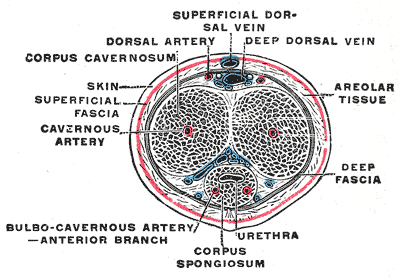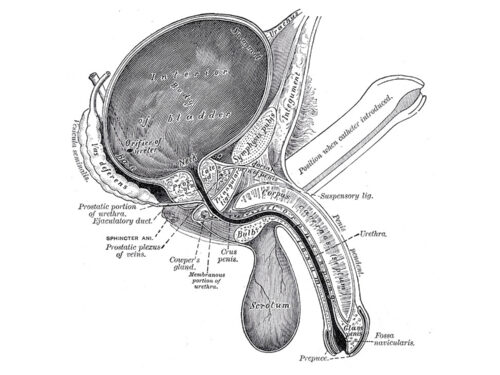There are a few reasons why some dicks curve and others don't, but by and large a curved dick isn't a problem. But it might seem like a problem given the tendency of pornography to feature penises that are ramrod straight. In reality, curves are almost always natural and nothing to be worried about, and in some ways can be a bonus. The majority of men have some degree of curvature, some more than others.

Penile anatomy
When it comes to understanding why a penis has a curve, it helps to understand the structure of the penis. The human penis is essentially a bundle of blood sponges wrapped in a skin balloon. These erectile tissue sponges — a pair of corpus cavernosum tubes on top and a corpus spongiosum on the bottom encasing the urethra — are fed blood by arteries and drained by veins.
When you get an erection, the arteries open up and the veins close up, increasing blood pressure inside and forcing the erectile tissues to expand. The fact that there are three such tubes is almost always the underlying cause behind a curve.
Uneven growth
The single most likely reason behind a penis having a curve is the fact that human bodies are imperfect and become even more imperfect as they grow. No human body is perfectly symmetrical, and that applies to penises as well. It only takes is for one of the erectile tissue tubes to be slightly shorter in its fully extended length to create a curve in that direction. It might not be obvious in the flaccid state, but once fully inflated the smaller tube finds itself pulling against its larger companions. Conversely, one of the tubes being larger than the others can lead to a curve away from that side.
When one of the two corpus cavernosum is shorter than the other, it can lead to a curve to that side, left or right. When the corpus spongiosum is shorter it can result in a downward curve, while a longer one may lead to a penis that curves up.
Again, it is perfectly normal for there to be asymmetry in the human body. Most of us have uneven faces and limbs, it should not a surprise that penises do the same.
Unbalanced blood supply
Even if the erectile tissues themselves are all properly sized such that the erection should be straight, issues with the blood supply in the penis can also lead to a curvature.
While the penis has a single artery that supplies it with boner-sustaining blood, that artery splits into multiple branches before entering the separate erectile tissues. A restriction or blockage in any one of those can lead to a decrease in blood supply to that side and thus reduced pressure and then a curve.
Conversely, if the veins that drain the penis experience a blockage or restriction they can increase the pressure on that side and cause a curve in the opposite direction. Veins can also fail to properly constrict, leading to reduced pressure and curvature as well.

Scarring
Internal scarring can cause penises to curve. The fibrous scar tissue doesn't stretch in the same way as the skin and erectile tissue, so its presence holds back that side of the penis from fully expanding, inducing a curve towards that side. Scar tissue is the most likely culprit when the curve is more of a "bend" in a single spot than a continuous curve.
There are multiple reasons why scar tissue may develop inside the penis. Obvious injuries like penile fracture can result in scar tissue forming around the wound site as the body heals. Less obvious injuries, including moderate bending under force and impacts, can cause scaring to develop. There's no guarantee that any of these will result in internal scar tissue, and there's no guarantee that such scar tissue with result in a curve.
Men are very familiar with the sensitivity of their own penis, so avoiding these scenarios shouldn't be too hard for most men. But if you believe you've suffered an injury to your penis that could result in scarring, please talk to your doctor before things get bad.
Peyronie's disease
Taking internal scarring to the next level is Peyronie's disease. This condition is where internal scar tissue has occurred to such a degree that erections have a significant bend and often result in pain. The curvature with Peyronie's can be so extreme that it inhibits normal sexual activity, and the scaring can be so severe that it results in erectile dysfunction.
The causes of Peyronie's disease are not known, but theories include a genetic predisposition to the rampant development of fibrous plaques, or the body going into scar tissue overdrive after a relatively minor trauma to the penis. It's possible that both may play a role, or that the two are separate conditions lumped under the Peyronie's banner. Peyronie's disease can occur seemingly overnight, or develop slowly over time.
Circumcision
Circumcision remains a controversial topic, the reasons behind it and opposition to it are not something that will be broached in this piece. What will be discussed is how botched circumcision can lead to penile curvature, especially when performed in adolescence or later instead of as an infant.
Circumcisions involves the surgical removal of the foreskin, followed by the healing of the remaining tissues, leaving the glans fully exposed. When a circumcision is performed poorly and too much skin is removed, the healed wound may leave not enough skin on a particular side for the penis to fully extend, resulting in a bend to that side. The vast majority of circumcisions are performed without incident, and even poorly performed circumcisions on an infant or young child are less likely to result in curvature as there is still significant penile development to occur.

Influence of size on curvature
Longer and thicker penises are not any more likely than shorter or thinner ones to develop a curvature. The biological processes that can lead to a curvature operate exactly the same way regardless of penis size. That said, a longer penis can have more of an apparent curve simply due to its size — given two penises with the same radius of curvature, the longer one will appear to have more of a curve just because it carrie the curve on for a greater distance.
Penile fracture is a greater risk with longer penises, as there is simply more dick to be bent during rough intercourse.
A curve can make a penis appear smaller, as it reduces the apparent length from base to tip. A curved penis isn't actually any smaller than if it were straight, but visually it can look that way. A road isn't any shorter because it has a curve in it! Measurement of a curved dick can present a challenge; the best option is to use a flexible tailors tape measure to get a length along the inside and outside of the curve, then averaging the two to get a close approximation of the midline length.
Underwear won't curve your dick
There is no evidence showing that clothing has any impact on a penis's curvature. It might make sense on a superficial level that tight briefs could result in a penis curving to whatever side it is worn, but the reality is that underwear is highly elastic and never so tight that it will restrict penis growth.
For every guy that has a penis that is curved to match how he dresses hiself, there's another that has a curve that doesn't match, or ended up with a curve despite wearing loose boxers.
So why does it seem like your curve matches your body and underwear. It's a coincidence that you have a relatively minor curve, and you simply wear your penis to the side where it's most comfortable. That's it.

Fixing a curved penis
For the most part, a curved penis is not something that is a medical concern or in need of correction. Curves up to 30º are considered to be within the realm of "normal", even if it doesn't meet the pornographic ideals we see in modern erotica. A substantial curve can be limiting in some positions (such as an upward curve being uncomfortable for the recipient in doggy), but it can also prove to be a bonus in stimulating areas a straight dick would struggle to reach. As with many things in life, you have no choice but to work with what you've been given.
For more extreme curves, medical intervention can be warranted. For curves that are the result of uneven growth, the only real option is the use of a traction device to manually straighten the penis. Worn over the course of several weeks or longer, the traction device applies a stretching force to the penis and can induce cellular division. While these are popularly marketed as length extenders, the primary recognized medical use for such devices is in curvature correction.
For men dealing with penile scar tissue, whether from injury or as a result or Peyronie's disease, treatment can take multiple courses and run through a few different stages. Injections of Interferon have been shown to be effective in preventing the formation of new scar tissue and even helped to break down existing scar tissues and reduce curvature. Collagenase injections have likewise been shown to break down scar tissues associated with Peyronie's and are currently under review by the FDA for such treatment.
Multiple oral medications have been tested and shown to have little impact on curvature correction, including vitamin E, potassium amino-benzoate, carnitine, and tamoxifen. Newer proposed treatments of ultrasound, shockwaves, and radiation are currently under study, but aren't widely expected to have a significant impact.
Surgery is also an option for the most severe curvature, especially those that result in pain with erections and where other treatments have proven ineffective. These surgeries can take a few different forms. One involves removing tissue from the opposite side of the curve to balance it out, and is considered the easiest and safest option, especially for men that already have an above-average penis. Another surgical option is to remove a problematic scar plaque and place a graft in its place, allowing that side to more fully extend, but this surgery is considered to be riskier and can result in more significant dysfunction.











